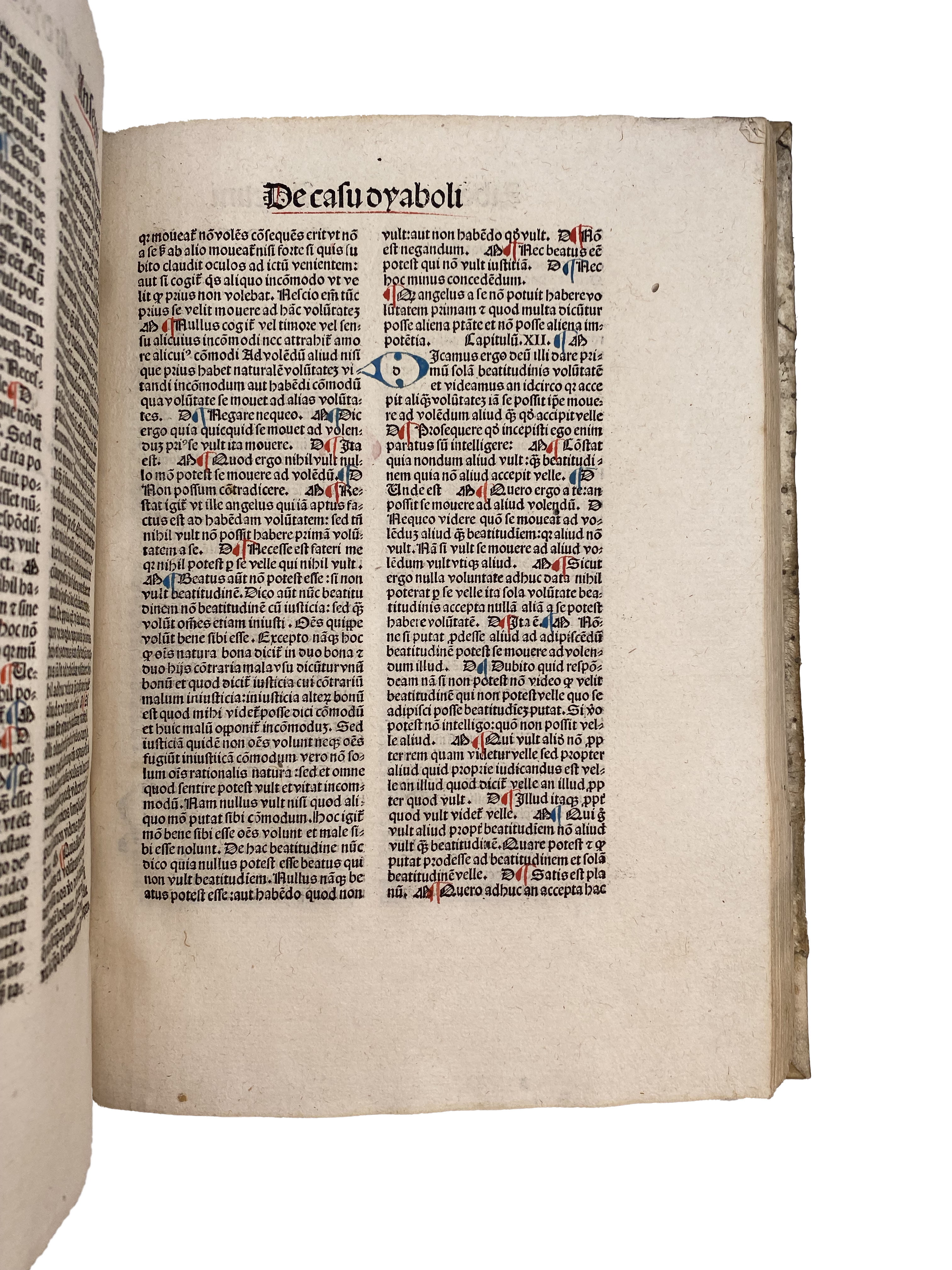ANSELM.
Opera
Nuremberg, Caspar Hochfeder, 27 Mar. 1491£9,500.00
FIRST EDITION. Small folio, 180 unnumbered leaves. Gothic letter, double column, red and blue hand-painted initials and paragraph marks. Half-title a bit dusty, a few almost entirely marginal small wormholes, tear and paper flaw two outer blank corners, tear to one lower blank margin, paper thinning to one fol. without loss. A very good, wide-margined copy, crisp and clean, on thick paper, in contemporary pigskin, covers blind ruled in a diaper pattern with blind stamped flower and crown- shaped tools, covers somewhat wormed and a bit rubbed, early ms. title to upper cover, spine with raised bands, missing clasps. Stub from a C14 manuscript with red initials containing sermons, part of the text appearing in Gulielmus Peraldus’ ‘Homiliae sive sermones’ and William of Auvergne ‘Guilielmi Parisis Sermones’. C16 ms. ex libris of the monastery of Kaisheim (Bavaria, Germany) “B(eatae) V(irginis) Mariae in Keisersheim” inside large initial on fol. a(recto) and ms. library annotation “N:106 Fr. Fr. Caesare” to half-title.
7cImportant and beautifully printed first edition of St. Anselm’s opera, with charming capitals supplied in red and blue. This was the first volume from the press of the German printer Caspar Hochfeder (active 1485-1517).
Anselm of Canterbury (c. 1033-1109) was one of the greatest exponents of Christian doctrine in the Middle Ages. Born to a noble family of Aosta (Italy), he entered the abbey of Notre-Dame du Bec at the age of eighteen and later became prior and abbot. In 1093, he was appointed Archbishop of Canterbury by William II Rufus. During his years in England, he played a major role in the Investiture Controversy, asserting that the king had no rights to interfere with ecclesiastical matters. Due to his activity in support of the Church, he entered in conflict with kings William II and Henry I and was twice exiled. An outstanding thinker and the father of Scholasticism – the leading philosophical and Christian school of thought in the Middle Ages – Anselm is best known for being the originator of the ontological argument for the existence of God: he argued that since God is the greatest and most perfect being, and it exists in the mind, then he must also exist in reality.
In addition to his many administrative and teaching duties, Anselm was a prolific author who composed several dialogues and meditations on theology and philosophy. This attractive edition is by the humanist Pierre Danhauser and it opens with a dedication to the Nuremberg scholar Jean Löffelholz, enthusiastically praising Anselm’s writings and comparing him to St. Jerome. After a biography of the author and two short introductory pieces (a prayer and a life of the Virgin Mary), Anselm’s collected works are presented. The volume contains 28 treatises, some spuriously attributed to Anselm. The most notable works of Anselm’s authentic corpus are ‘Monologion’ and ‘Proslogion’, dialogues on the existence of God, and ‘Cur Deus Homo?’ (Why God Became a Man?) introducing a theory on how Christ redeemed humanity. Also thought-provoking are three shorter dialogues ‘De Veritate’, ‘De Libertate Arbitrii’ and ‘De Casu Diaboli’, concerning free will and fallen angels. Fourteen ‘Epistolae’, letters by Anselm, are included (out of the the c. 400 known).
Others in this collection discuss traditional theological topics, such as God’s will and nature, the virgin Mary, the passion of Christ and the cross. ‘Liber pro insipiente’ was written by the Tours monk Gaunlio against Anselm’s ontological argument, here followed by Anselm’s reply (Liber apologeticus). The most curious is perhaps ‘De imagine mundi’, by the theologian Honorius Augustodunensis (c. 1080 – c. 1140), a popular medieval encyclopaedia of geography, cosmology and astronomy, comprising a chronicle of the world history.
USTC 742883; ISTC ia00759000; Goff A759; BMC II 473; GW 2032; Brunet I, p. 304; Graesse I, p. 139.In stock








